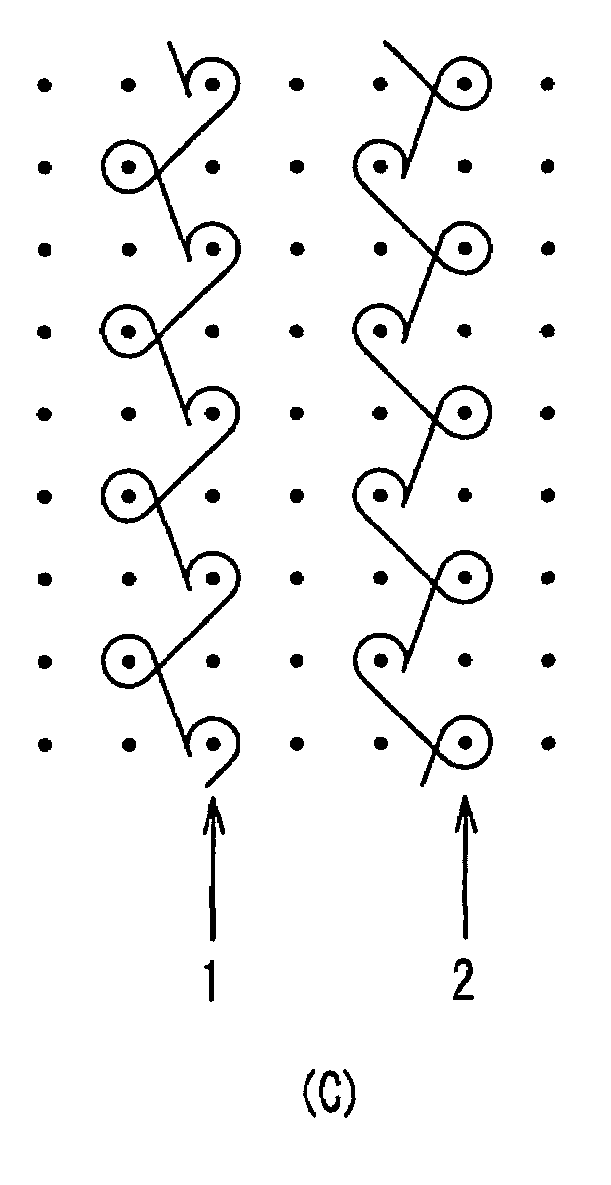Stretchable warp-knitted fabric, method for manufacturing the same, and stretchable clothing using the same
a technology of stretchable knitted fabric and manufacturing method, which is applied in the direction of textiles and papermaking, weft knitting, knitting, etc., can solve the problems of affecting the comfort of wearing, affecting the wear comfort, and the above-mentioned knitted fabric has a disadvantage of poor stretchability
- Summary
- Abstract
- Description
- Claims
- Application Information
AI Technical Summary
Benefits of technology
Problems solved by technology
Method used
Image
Examples
example 1
[0070]A 1×1 tricot was knitted by using a micro full-dull nylon yarn with a fineness of 44 dtex / 34 filaments as a non-elastic yarn and a polyurethane transparent yarn (bright yarn) having a fineness of 44 dtex as an elastic yarn with two guide bars and allowing them to run side by side, in such a manner that both the yarns formed closed loops as shown in FIG. 2, by using a raschel knitting machine for a knitting width of 130 inches (330.2 cm). The total number of yarns was set to be 3600, so that a finished width of knitted fabric was set to be 130 cm (about 70 wales / inch) in the present example, although the finished width of the knitted fabric usually was supposed to be about 160 cm, whereby a knitted texture with a high density was obtained with a smallest possible width. Furthermore, the runner of the nylon yarn was set to be 100 cm / rack in the present example, although it was supposed to be set at 80 cm / rack or less in typical knitted fabric. The runner of the polyurethane yarn...
example 2
[0071]A 1×1 tricot was knitted by using the same nylon yarn as that used in Example 1 as a non-elastic yarn and a polyurethane transparent yarn with a fineness of 78 dtex as an elastic yarn with two guide bars and allowing them to run side by side, in such a manner that a non-elastic yarn 1 formed closed loops and an elastic yarn 2 formed open loops as shown in FIG. 3, by using the same knitting machine as that used in Example 1, and finished with the same narrow width as that in Example 1. Furthermore, the runner of the nylon yarn was set to be 110 cm / rack in the present example, although it was supposed to be set at 80 cm / rack or less in ordinary knitted fabric. The runner of the polyurethane yarn was set to be 100 cm / rack, although it was supposed to be set at 80 cm / rack or less in ordinary knitted fabric. The knitted fabric thus formed was subjected to heat set in the same way as in Example 1. The outer appearance of the resultant knitted fabric was well arranged and very attrac...
example 3
[0072]A 1×1 tricot was knitted by using a nylon yarn of 33 dtex as a non-elastic yarn and a polyurethane transparent yarn with a fineness of 44 dtex as an elastic yarn with two guide bars and allowing them to run side by side, in such a manner each yarn formed open loops and closed loops alternately, and in each stitch, an elastic yarn 2 formed a closed loop with respect to an open loop formed by a non-elastic yarn 1, and similarly, the elastic yarn 2 formed an open loop with respect to a closed loop formed by the non-elastic yarn 1 as shown in FIG. 4, by using the same knitting machine as used in Example 1, and finished with a narrow width of 130 cm. Furthermore, the runner of the nylon yarn was set to be 110 cm / rack, although it was supposed to be set at 80 cm / rack or less in ordinary knitted fabric. The runner of the polyurethane yarn was set to be 95 cm / rack, although it was supposed to be set at 60 cm / rack or less in ordinary knitted fabric. The knitted fabric thus formed was s...
PUM
 Login to View More
Login to View More Abstract
Description
Claims
Application Information
 Login to View More
Login to View More - R&D
- Intellectual Property
- Life Sciences
- Materials
- Tech Scout
- Unparalleled Data Quality
- Higher Quality Content
- 60% Fewer Hallucinations
Browse by: Latest US Patents, China's latest patents, Technical Efficacy Thesaurus, Application Domain, Technology Topic, Popular Technical Reports.
© 2025 PatSnap. All rights reserved.Legal|Privacy policy|Modern Slavery Act Transparency Statement|Sitemap|About US| Contact US: help@patsnap.com



